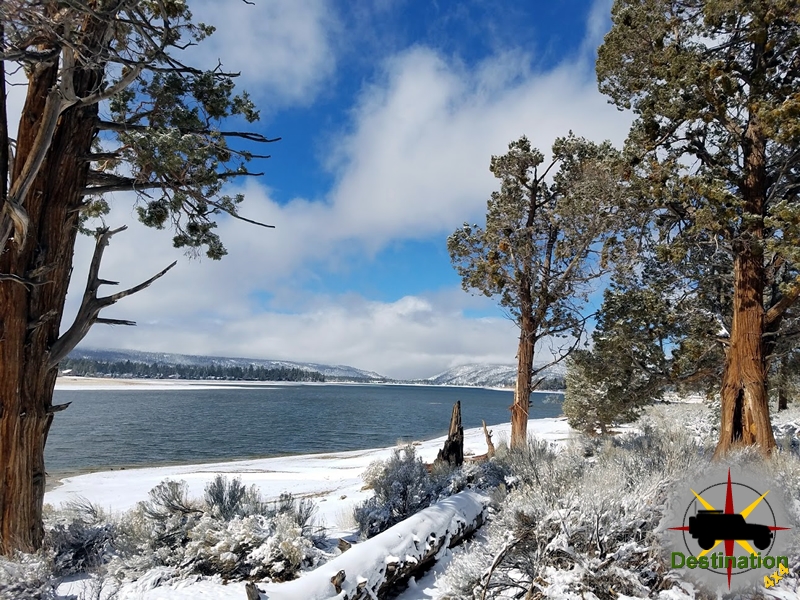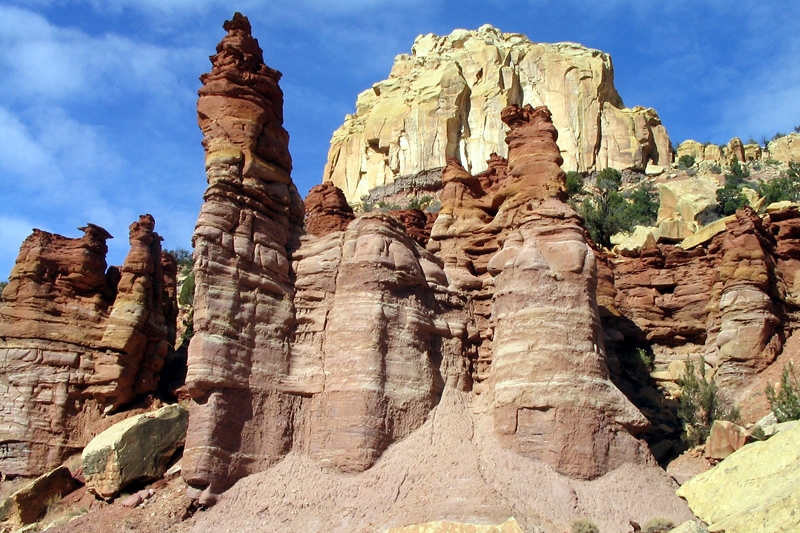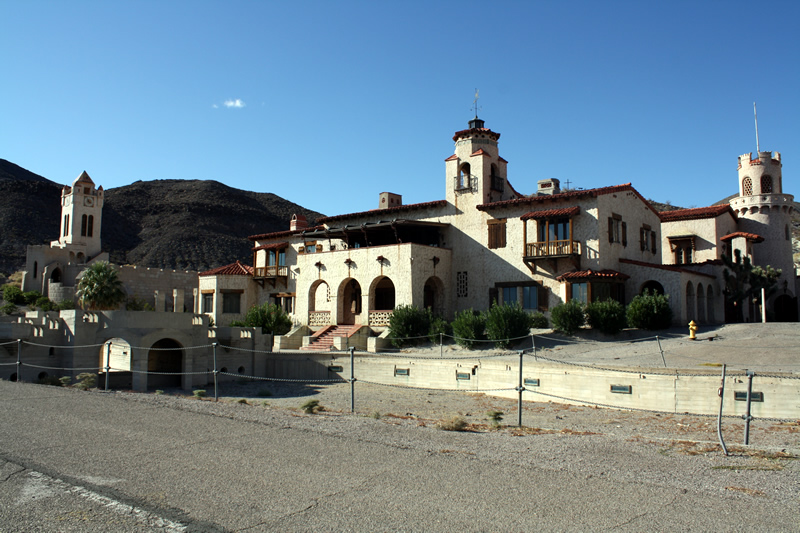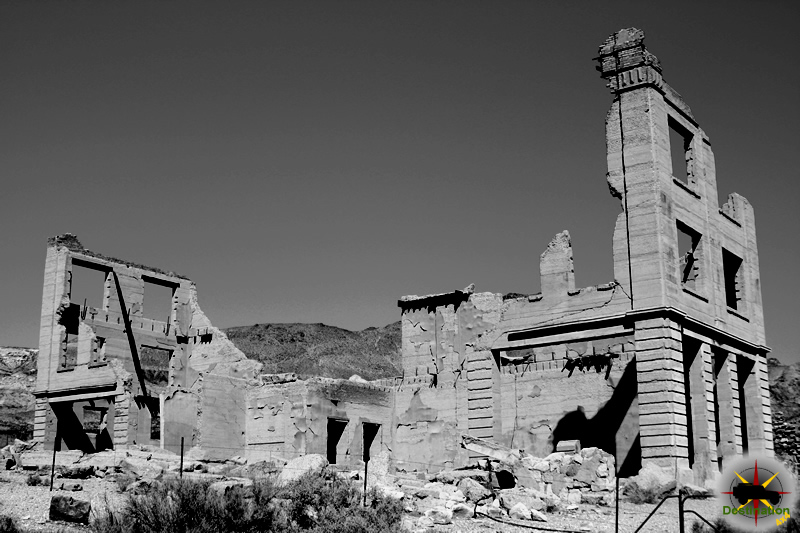
Nivloc Nevada – Esmeralda County Ghost Town
In 1907, Gold was discovered at the town site which would be known as Nivloc Nevada by a Native American prospector. The town derived its name from for the former owners “Colvin” who operated the site in 1923. The name spelled backwards was Nivloc and such is the haste in the Nevadan desert.
The original mining operations were short lived. The town experienced a bit of a resurgence in the 1930s. The town never amounted to much boasting only one saloon. At its height of operation from 1940 to 1943 the town could claim a post office. Between 1937 and 1943 the small town produced between $2 and $3 million dollars of Gold and Silver. The 400,000 tons of ore was pulled from mines reaching depths 440 feet and 600 feet of below the surface. During this time, the mines of Nivloc ranked as Nevada’s number one silver producer.
Nivloc Today
We have not made a trip to Nivloc, however the townsite is very high on my ghost town “to do” list. There are several standing structures and buildings intact. The mine headframe is still standing at and a rail trestle bridge which is one hundred and twenty feet in length and forty feet tall.
Town Summary
| Town | Nivloc, Nevada |
| Location | Esmeralda County, Nevada |
| Latitude, Longitude | 37.71583, -117.75722 |
| Elevation | 6,170 feet |
| GNIS | 851592 |
| Post Office | October 1940 to November 1943 |
Nivloc Map
Resources
Weepah Nevada – Esmeralda County Ghost Town
The site of the last major gold rush in 1927, Weepah Nevada is a ghost town and gold mine site located in Esmeralda County. Named for the Shoshone word for “rain water”, the townsite was formed in 1902 when gold was discovered in shallow pockets by Indians. A modest rush of 200 people found their way to the small outpost, however the district would soon go dormant and stay that way for the next twenty five years.

Gold was rediscovered in March 1927 by Leonard Trayner and Frank Horton, Jr. from Tonopah. Initial assay results valued the ore at $70,000 per ton. News of this strike could not be kept quiet and spread out like wildfire across the nearby mining communities of the desert and beyond.

Twenty years prior would have seen an influx of wagons and horses bringing in the miners. Weepahs gold rush was powered by the newly available automobile. The auto powered the rush and the speed of the boom and within one week of the new of “gold” in Weepah, the town was bursting with over 1,000 people searching for their fortune in the hills. Many of these miners came via auto and were fully equipped and supplied well, often even driving new cars to the site an known as “mail order prospectors”. Soon, wooden frame houses rose above the older city which was comprised from a sea of tents. The town could be found from three roads, which were often jammed with autos as the towns population was between 1500 and 2000 people.
Regardless of production, reporters filed daily briefings and international newsreels informed the population of the ongoing modern gold rush. In April, the build boom continued with about 60 wooden framed buildings and over a dozen mining companies. Despite the promotion and news reels, interest in Weepah waned in July 1927. The last great gold rush in Nevada was over when the “mail order prospectors” broke camp and ran from the realities of the Nevadan desert.
Weepah Nevada Map
Town Summary
| Name | Weepah, Nevada |
| Location | Esmeralda County, Nevada |
| Latitude, Longitude | 37.931876389209,-117.5600734418 |
| GNIS | 856169 |
| Elevation | 6.165 Feet |
| Population | 1,500 – 2,000 |
| Post Office |
Resources
Charles Milles Maddox
Charles Milles Maddox AKA Charlie Manson was a serial killer and most of the bad parts of the Old Testament sort of criminal. He briefly lived in the Panamint Mountains on the western edge of Death Valley National Park.

Introduction
As a preface, I would like to say that I have been extremely reluctant to include Maddox on my website. I do not wish to glorify him in anyway. Growing up in the 1970s, just a few miles from the La Bianca house, I can not remember when I first heard of Manson. Our family loved the 395 highway and knew some law enforcement officers in Lone Pine, Inyo County.
Long Story Short
Most books and movies of Manson tend correctly focas on the Tate-La Bianca murders. In summary, Manson, a career criminal, is release from prison. He meets young women and uses the girls to attack young men with sex a drugs. Over the coarse of about two years, he forms them in a cult of followers who live at Spahn movie ranch.. On August 9th and 10th, 1969, Manson orders these followers to slaughter 7 people in their homes.
After the murders, the family cult moves to Barker Ranch in Goler Wash, in Death Valley. It is here that he is captured for vandalizing some earth moving equipment and auto theft. Once captured, he is connected to the murders in Los Angles, tried and convicted by Vincent Bug
Panamint Charlie

Mansons original destination is the Myers Ranch in the Panamint Range. In October, 1968, he started to look for a desert location to move his “brood”. He choose the desert because “Out there, things aren’t so crazy”. (Ironic) One of his followers is Cathy (Cappy) Gilles is a grand daughter of Bill and Barbara Myers. “Cappy” obtained permission from the family matriarch for her and some girls to come up and stay at the ranch. One can not help to wonder if the true purpose of moving them to the Panamint mountains is to further isolate his followers from society.
Additionally, Manson supposedly discussed operating out of Barker Ranch with the owner Arlene. He convinced her he was a musician working on a record and would maintain the property for her. He gave her a Beach Boys gold album in payment, which would undoubtably prove his claims of being a musician. Between 40 acres at Myers Ranch and 5 acres at Barker, he had control over 45 acres of property in the sparsely populated Panamint Mountains.
The family stayed in Goler Wash from October 1968 to about January 1969. The family of nineteen people travelled using a school bus to the mouth of Goler wash, and would hike in with supplies up the ranch house. During this time, they made regular trips back down to Los Angeles or over to Las Vegas. The family would regularly shop for supplies in Ballarat which still had a small population and general store.
In the winter months of 1969, Manson and his followers returned to Los Angeles. They stayed at several other locations beside the infamous Spahn movie ranch. During this time, they continued to steal cars, deal drugs, probably prostitution and all in all anything to make money and “acquire” supplies.
Desert Deterioration

After the Tate-La Bianca murder in August of 1969, Charles Milles Maddox and his cult travelled back up to Goler Wash. This time he setup operations around Barker Ranch. Paul Watkins was a former follower who left the family before the murders. His book is fascinating.
Prior to Charlies arrival, Watkins and some prospectors where living at Barker Ranch. Watkins received guidance from a prospector named Crockett who helped Watkins leave the family. Manson knew of Crockett’s influence over Watkins and recognize an adversary. Upon his arrival, Manson asked permission to enter the area. As Watkins et al where living in Barker Ranch, the Manson Cult moved into the Myers Ranch.
Over the next few weeks, Charlie Manson continued his mental downward spiral. At the time, the neighbors at Barker Ranch knew Charlie was dangerous, however did not know about his guilt in the Los Angeles Murders. Crockett would have philosophical conversations and push the boundaries of Manson. This prompted the unstable Manson to come visiting the occupants at Barker ranch in the middle of the night. On at least two attempts he was caught trying to sneak into the ranch house while the occupants slept. He was greeted with the muzzle of a shotgun and left into the night.
Manson is said to have driven around the area of the Panamint mountains and Death Valley looking for a hole in the earth. These excursions opened the door into the capture of the psychopath. During this time he continued to prepare for a racial war he thought was coming.
Investigation
The beginning of the end for Manson started with a report of a fire on a Michigan front loader out at Racetrack valley. The front loader was moved to the playa in Race Track Valley to repair damage to the playa surface by off-roaders. On September 19th, 1969, Manson ordered the some family members to burn the machine because he construed it to be the device of environmental damage. Oddly enough, it was there to repair environmental damage…. This decision by Manson set in place a series of events which led to his capture and a life time in jail.
Inyo County officials were extremely upset about the loss of their newly acquired $35,000 earth moving equipment. They quickly dispatch officers and launched an investigation.
Park Rangers arrived at the scene of the fire sometime later. They noted several tire tracks leading away from the fire. One set of tire tracks belonged to a Toyota Land Cruiser. Follow up investigation included reports of a Red Toyota Land Cruiser driving around in the area. It was reported this Red Land Cruiser is driven by some hippies who lived up at Barker Ranch.
October 9th, 1969
On October 9th, CHP Officer Jim Pursell and Park Ranger Dick Powell drove up to Barker Ranch approaching from Mengel Pass. They ran into two of Mason’s girls and lacking evidence moved on down Goler Wash. In doing so, the came across Brooks Poston and Paul Crocket. When questioned why he was hauling supplies for the groupd Crocket replied, ‘‘I think my life might depend on it.’
The two men are instructed to return to Barker Ranch. On questioning about Manson, Brooks and Crocket told the two men about the families activity. According to Paul Watkins, Crocket left the ranch for fear of Manson was going to attract law enforcement. This event s probably because Crockett told law enforcement. Pursell noted that a VW was hidden beneath a purple nylon parachute beneath a trash heap. nd recorded the VIN number.
The two men left the ranch again and travelled down Goler Wash they stopped at a draw. Dick Powell started up the draw and was soon within a group of naked young women, one of who is Squeaky Fromme. Fromme claimed to be part of a girl scout troup from San Francisco and with no other evidence, the two officers continued down the valley.
A Series of Raids
Enroute to Trona, the two law enforcement officers found out over the radio that the car was stolen and a predawn raid is slated for the following morning. Looking forward to a long night, the two men hand dinner in Ballarat before parking at the mouth of Goler Wash.
October 10th
The first raid took place on October 10th, 1969. Just before dawn, a small task force made up of officers from the California Highway Patrol, Inyo County Sheriff’s Department, and the National Parks Service maneuvered into position around Barker Ranch. The cult members had pilled rocks up along the road, which necessitated the officers travel on foot.
At first, it seemed the operation was a success. The task forced found several stolen cars and dune buggies. Weapons suchs a pistol, knives, food, gasoline, and other survivalist supplies confirmed that the cult was building a stronghold in the desert for the long haul. They arrested three men, ten girls, and two babies, one of them just a few weeks old. A count of the number of sleeping bags informed the task force they had not captured everyone involved.
October 12th
On the evening of October 12, the small force of park rangers headed back to Barker Ranch. From an observation point, the witnessed four people walking towards the cabin and entering the building. One of the people is covered head to tow in a buck skin outfit and obviously the leader.
The task forced stormed the ranch with guns drawn. The ordered the occupants inside to raise their hands. They met no resistance. The man dressed buckskin is nowhere to be found.
Charles Milles Maddox Capture
Following the raid, Jim Pursell search for the buckskin man. He enters the bathroom where is sees a very small cabinet. The door is slightly open and he notices a few long hairs sticking out. In the failing evening light, armed with a candle and a .357 revolver, Pursell noticed some fingers wiggling inside.
Pursell later recounted “I put the candle way down, and this figure starts unwinding and coming out. How he got into that cupboard, I’ll never know. He’s not big. I’ve had a lot of people ask me, ‘Why didn’t you shoot the son of a bitch?’ But again, we really didn’t know what we had, and you can’t just shoot somebody that climbs out of a little cupboard, and says [cheerily], ‘Hi! I was pointing the gun at him and told him exactly what I wanted him to do, and what not to do. ‘Make one wrong move and I’ll blow your head off.’ I ask his name, and he said, simply, ‘Charlie Manson.’ Right off. I led him out to the guys outside”
The raid of October 12th lead to arrest of six males and three more females. All in all the bravery of the CHP, INYO Sheriffs and Park Rangers led to the apprehension, conviction and sentencing of one of the worlds most notorious people, Charles Milles Maddox. The cult or family that Manson started literally killed many and ruined the lives of hundreds of people. The story of Mansons life in the Panamint Mountains of Death Valley is more fascinating that the typical most people will understand and his activities in Death Valley are far larger than “Barker Ranch.”
Manson’s Locations in and around Death Valley
 Ballarat California – Inyo County Ghost TownBallarat, California Located in Inyo County, Ballarat California is a ghost town which supposedly has a few residents living their dream within the town. Ballarat… |
 Barker RanchThomason/Barker Ranch is a five-acre property within Death Valley National Park. This historic site is located off of Goler Wash in the southern Panamint Range… |
 Myers RanchMyers Ranch is a privately owned ranch located in Goler Wash in the Panamint Mountains of Death Valley National Park, California. The forty acre ranch… |
 Racetrack ValleyTeaKettle Junction lets you know you are starting to get close to the Racetrack. Racetrack valley is a rough graded road which departs the Ubehebe… |
 Warm Springs RoadA short side trip from the Saline Valley Road to the Saline Valley Warm Springs in Death Valley National Park, California. The road is used… |
References
Gideon Roberts
Gideon Roberts was a minor but notable figure in the legend of the Lost Dutchman Gold Mine, a fabled gold deposit hidden in Arizona’s Superstition Mountains. Little is known about his personal life, as historical records provide sparse details, and he is primarily referenced in connection to the events surrounding Jacob Waltz’s death in 1891.
The Lost Dutchman’s Gold Mine
The Lost Dutchman Gold Mine is a legendary treasure shrouded in mystery, believed to be hidden in the rugged Superstition Mountains of Arizona. The tale originates from Jacob Waltz, a German immigrant known as “the Dutchman,” who allegedly discovered a rich gold vein in the mid-19th century but took its precise location to his grave in 1891. Over the years, the mine has become a focal point of American folklore, with countless prospectors, adventurers, and treasure hunters scouring the treacherous terrain for clues, guided by vague maps, cryptic stories, and supposed landmarks like Weaver’s Needle. Despite extensive searches, no verified evidence of the mine’s existence has been found, leading some to dismiss it as a myth, while others believe it remains concealed, protected by the mountains’ harsh conditions and the secrecy of its original discoverer. The legend persists, fueled by tales of danger, betrayal, and untold riches.
Early Life and Background
Virtually no verifiable information exists about Gideon Roberts’ birth, upbringing, or early life. Some accounts suggest he was a Phoenix local and possibly a miner by trade, as he owned a lot in Phoenix near Julia Thomas’ property around 1891. One source indicates he hailed from Trinidad, Las Animas County, Colorado, and spent winters in Phoenix, but this lacks corroboration. His age is also unclear, though some narratives describe him as significantly older than his associate, Dick Holmes, and possibly closer in age to Jacob Waltz, who was around 80 at the time of his death.
Role in the Lost Dutchman Legend
Gideon Roberts is most prominently mentioned in connection to the deathbed scene of Jacob Waltz, the German immigrant known as “the Dutchman,” who allegedly discovered the mine. In October 1891, Waltz was gravely ill with pneumonia and was being cared for by Julia Thomas in Phoenix. According to accounts, Thomas left to find a doctor and encountered Roberts and Dick Holmes, a young prospector, on the street. She brought them to her home to watch over Waltz. That night, on October 25, 1891, Waltz reportedly shared the location of his mine and bequeathed a box containing 48 pounds of rich gold ore to Holmes, with Roberts present as a witness.
Roberts’ presence during this pivotal moment lends credibility to Holmes’ claim to the gold and the mine’s clues, as he corroborated Holmes’ story. However, unlike Holmes, who spent years searching for the mine, there is no definitive record of Roberts actively pursuing it himself. Some sources speculate he may have been too old or lacked the means to undertake such a quest.
Later Life and Legacy
Details about Gideon Roberts’ life after 1891 are scarce. It is generally reported that he died shortly after Waltz’s death, though no specific date or cause is provided in most accounts. This lack of information has led to speculation about his role and even his existence, with some modern researchers questioning whether he was a distinct individual or conflated with other figures in the legend. For example, one source references a “Gideon O. Roberds” (note the spelling variation) as a possible identity, but this remains unverified.
Roberts’ legacy is overshadowed by more prominent figures like Dick Holmes and Julia Thomas, and he is often omitted from detailed retellings of the Lost Dutchman story. His brief role as a witness to Waltz’s final moments remains his primary contribution to the legend, adding a layer of intrigue to the conflicting narratives surrounding the mine’s location.
Historical Context and Challenges
The scarcity of information about Gideon Roberts reflects the broader challenges of the Lost Dutchman legend, which is riddled with contradictory accounts and unverifiable details. Most books on the subject focus on Waltz, Holmes, or later treasure hunters, leaving Roberts as a footnote. His fleeting presence underscores the elusive nature of the mine itself, which has captivated treasure hunters for over a century but remains undiscovered.
Mojave Poppy ( Eschscholzia glyptosperma )
Eschscholzia glyptosperma, commonly known as the desert gold poppy or desert poppy, is a species of flowering plant in the Papaveraceae family. This annual herb is native to the southwestern United States and northern Mexico, thriving in arid and semi-arid environments. This report aims to provide a comprehensive overview of the morphology, habitat, ecology, and uses of Eschscholzia glyptosperma.

Taxonomy and Nomenclature
- Kingdom: Plantae
- Clade: Angiosperms
- Clade: Eudicots
- Order: Ranunculales
- Family: Papaveraceae
- Genus: Eschscholzia
- Species: E. glyptosperma
Morphology
Eschscholzia glyptosperma is characterized by the following features:
- Roots: The plant has a taproot system that allows it to access deep water sources, which is crucial for survival in arid environments.
- Stems: Stems are typically slender, erect, and can range from a few centimeters to about 30 centimeters in height.
- Leaves: The leaves are finely divided and bluish-green, arranged in a basal rosette. They are pinnately divided into narrow, linear segments.
- Flowers: The flowers are bright yellow to orange with four petals, each petal often having a distinct darker spot at the base. Flowers are about 2 to 5 centimeters in diameter and are borne on long peduncles.
- Fruits: The fruit is a slender capsule, known as a silique, which contains numerous small, reticulated seeds.
Habitat and Distribution
Eschscholzia glyptosperma is adapted to desert and semi-desert habitats, typically found in sandy or gravelly soils. Its distribution includes:
- Geographic Range: It is native to the southwestern United States, including Arizona, California, Nevada, and Utah, as well as northern Mexico.
- Elevation: The plant can be found at elevations ranging from sea level up to 2,000 meters.
- Climate: It thrives in regions with hot, dry summers and mild, wet winters, which is typical of desert climates.
Ecology
Eschscholzia glyptosperma plays a significant role in its ecosystem:
- Pollination: The flowers attract a variety of pollinators, including bees, butterflies, and other insects, which are crucial for its reproduction.
- Adaptations: The plant has several adaptations to survive in harsh desert conditions, such as a deep taproot system for accessing water and seeds that can remain dormant during unfavorable conditions.
Reproduction and Life Cycle
Eschscholzia glyptosperma is an annual plant, completing its life cycle within a single growing season. Key stages include:
- Germination: Seeds germinate in the winter or early spring following rains.
- Growth: The plant grows rapidly, forming a basal rosette of leaves and then producing flower stems.
- Flowering: Flowering occurs from spring to early summer, depending on rainfall and temperature.
- Seed Production: After pollination, the plant produces fruits that release seeds, which can remain viable in the soil seed bank until conditions are favorable for germination.
Conservation and Uses
- Conservation Status: Eschscholzia glyptosperma is not currently listed as threatened or endangered. However, habitat destruction and climate change could impact its populations.
- Uses: While not widely used in traditional medicine or agriculture, the plant is valued for its aesthetic appeal in wildflower gardens and for its role in supporting pollinators.
Eschscholzia glyptosperma is a resilient and ecologically important species adapted to the challenging conditions of desert environments. Its striking flowers and role in supporting pollinators make it a valuable component of its native habitats. Conservation efforts should focus on preserving its natural habitats to ensure its continued survival.
References
- Baldwin, B.G., Goldman, D.H., Keil, D.J., Patterson, R., Rosatti, T.J., & Wilken, D.H. (Eds.). (2012). The Jepson Manual: Vascular Plants of California, Second Edition. University of California Press.
- Hickman, J.C. (Ed.). (1993). The Jepson Manual: Higher Plants of California. University of California Press.
- U.S. Department of Agriculture, Natural Resources Conservation Service. (2024). PLANTS Database: Eschscholzia glyptosperma. Retrieved from plants.usda.gov.






